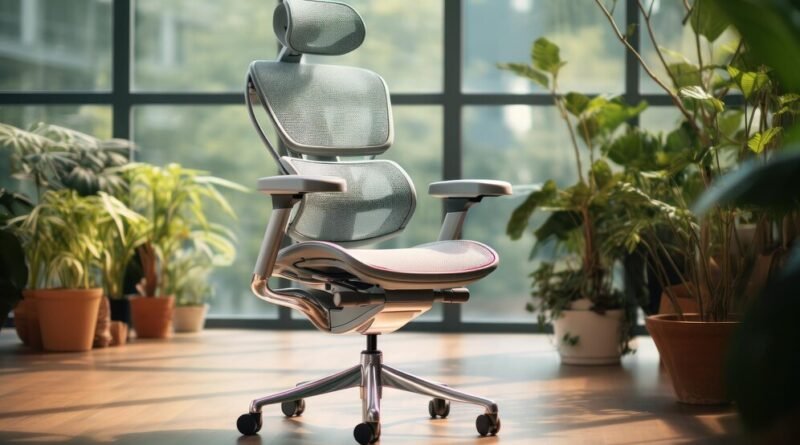The Complete Guide to Selecting Your Ideal Office Chair
Long stretches of time spent sat at a desk are now standard in today’s workplace. In order to preserve comfort and productivity while avoiding health problems, selecting the appropriate office chair is essential. Everything you need to know about choosing the ideal office chair is covered in this thorough guide, from kinds and materials to ergonomics and extra functions.
Types of Office Chairs
Task Chairs

The most adjustable alternative are task chairs, which provide a variety of settings for armrests, back angle, and seat height. With features like lumbar support and breathable mesh that guarantee comfort and good posture all day, these chairs are perfect for extended periods of sitting.
Executive Chairs

Executive chairs are a byword for class and power. These chairs, with their high backs, luxurious cushions, and striking appearance, are ideal for an elegant home office or executive setting. Even while comfort and style are given priority, they also have important ergonomic qualities.
Mesh Chairs

Mesh chairs are ideal for people who easily become hot or for warmer areas. You can stay cool and comfy on these chairs thanks to their superior ventilation. Because they are usually portable and lightweight, they are a popular option for contemporary office settings.
Kneeling Chairs

By using your core muscles and relieving strain on the lower back, kneeling chairs help you maintain better posture. For those with persistent back pain, they can be very helpful, even though they could take some getting accustomed to. Over time, these chairs can help reduce discomfort by encouraging a more active sitting posture.
Standing Desks and Chairs
Standing chairs and workstations are an option for people who want to avoid spending a lot of time sitting. These configurations facilitate leaning or perching, which enhances blood flow and lessens weariness. People who wish to add more movement to their workday will find them especially helpful.
Key Considerations
Adjustability
Adjustability is a crucial attribute to look for in an office chair. Chairs with lumbar support, armrest, and seat height adjustments allow you to tailor the chair to fit your body precisely. This lowers your risk of developing back pain and other problems by ensuring that you keep good posture.
Material
Both comfort and durability are greatly influenced by the chair’s material. Breathability is a feature of mesh chairs, luxury and durability are offered by leather seats, and cost is balanced by fabric chairs. Select a resource that is appropriate for both your workspace and personal tastes.
Ergonomics
Long-term health and comfort depend heavily on ergonomic factors. A waterfall seat edge, a curved backrest, and adjustable lumbar support are features to look for in chairs. Proper posture and less pressure on the spine are encouraged by these characteristics that help you distribute your weight evenly.
Weight Capacity
Make sure your weight can be supported by the chair of your choice. The majority of office chairs have a weight limit; make sure you examine this information to make sure the chair will be secure and comfortable for you.
Additional Features to Consider
Headrest
By giving your head and neck more support, a headrest relieves tension and encourages better posture. This is a very useful tool for people who work long hours at a desk.
Footrest
More specifically for those whose feet don’t lie level on the ground, a footrest can aid with better posture and circulation. The overall comfort level can be greatly impacted by this function.
Armrests
If you want to prevent strain on your arms and shoulders, you must have adjustable armrests. Seek out chairs with movable armrests to accommodate your body type and work style. These should have height and width adjustments.
Warranty
A quality warranty ensures that your investment is protected and protects you against problems, giving you piece of mind. Before making a purchase, make sure you read the warranty terms to find out what is and isn’t covered.
Finding the Right Fit
Try Before You Buy
Try to sit in the chair for at least fifteen minutes to make sure it feels comfortable and supports your lower back. Making a decision with greater knowledge can be aided by this practical experience.
Proper Fit
When seated, your feet should be flat on the floor and your arms should be bent at a 90-degree angle. Make sure there’s a tiny space between the back of your knees and the seat’s edge when it comes to seat depth on the chair.
Specific Needs
Take into account any particular requirements you may have, such as a mesh chair if you tend to get hot easily or extra lumbar support for back problems. You may greatly increase your comfort and productivity by customizing the chair to meet your needs.
Investing in Your Health
An investment in your health can be made with a high-quality office chair. You may lessen pain and suffering, increase productivity, and preserve better health by selecting a chair that supports your body correctly. It’s time to get a chair that supports you like a king or queen and get rid of that old, painful one.
Conclusion
Maintaining comfort, productivity, and general well-being all depend on selecting the correct office chair. You may establish a more pleasant and healthy work environment by taking into account the elements mentioned in this guide and choosing a chair that meets your unique needs.
Frequently Asked Questions (FAQs)
1. Why is an ergonomic chair important? The natural curvature of your spine is supported by an ergonomic chair, which lowers your chance of developing back discomfort and other musculoskeletal problems. Better posture, comfort, and productivity are encouraged by it.
2. How do I know if an office chair is the right fit for me? Make sure there is a tiny space between the back of your knees and the seat edge when it comes to the chair’s seat depth. When utilizing the armrests, your arms should bend to a 90-degree angle and your feet should remain flat on the ground.
3. What is the difference between a task chair and an executive chair? Executive chairs emphasize luxury and design with high backs and luxurious cushions, perfect for a chic home office, while task chairs are adaptable and have numerous adjustments for extended periods of sitting.
4. Can a mesh chair provide enough support? Yes, mesh chairs can give more ventilation and support at the same time. To guarantee comfort, look for models with lumbar support that can be adjusted.
5. Are kneeling chairs suitable for everyone? Chairs that are kneeling can help people with persistent back discomfort by encouraging improved posture. They aren’t appropriate for everyone, though, and they could take some getting accustomed to.
6. What features should I prioritize for long sitting hours? Prioritize materials that provide comfort and durability, adaptability, and ergonomic features like waterfall seat edges and lumbar support for extended periods of sitting.
7. How often should I replace my office chair? The quality and use of an office chair determine how long it will last. While less expensive alternatives would need to be replaced after a few years, high-quality chairs can endure up to ten years.
8. Is a warranty important when purchasing an office chair? Indeed, a quality warranty guarantees the security of your investment and provides protection against problems. Verify the warranty details to find out what is and is not covered.
9. Can I use a standing desk chair with a regular desk? Indeed, you can utilize standing desk chairs with standard desks to encourage improved posture and lessen tiredness. Make sure the chair can be adjusted to the right height for your workstation.
10. What material is best for an office chair? The ideal material will vary based on your tastes and place of work. Fabric strikes a mix between comfort and affordability, leather is opulent and long-lasting, and mesh allows for breathability.




